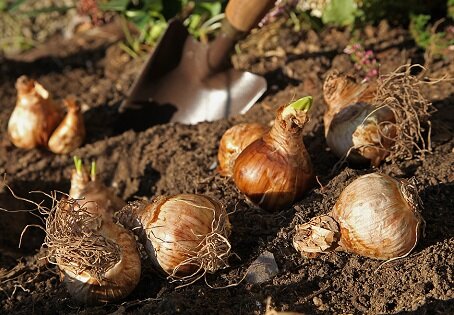A Taste of Winter
Here I am again writing as the weather changes from a taste of winter back to fall after we enjoyed a couple almost 70 degree days. If you think you are whirling on a rubber band imagine what the trees are thinking. Well, maybe not “thinking”, but you know what I mean. After the heavy, wet snow many trees lost leaves similar to our two summer hail storms, but other trees are still green and holding their leaves. Deciduous trees lose their leaves because they need to save energy for the winter. Leaves are programed to self-destruct. Trees can sense the shorter days as well as the change in the quality of the light. As the daylight declines chlorophyll (what makes the leaves green) production decreases allowing the carotenoid (yellow, orange, brown) and anthocyanin (red, purple) leaf pigments to give us a color show. The quality of the color show can be affected by weather and soil moisture. The timing of the color change seems to be genetically programed. Warm, sun-lit days with crisp cool nights make for the best color show. This fall many leaves have been frozen before they could change color.
Last week I was at a seminar on trees. The keynote speaker was Tony Kirkham from The Royal Botanic Gardens, Kew, UK. You can imagine the great slides of amazing trees! Full disclosure, Tony has 330 acres to work with and over 14,000 trees to manage. He subscribes to the school of thought that trees need clear open soil at the base of the tree and wood and/ or leaf mulch on the root zone. He also recommends digging a square planting hole instead of a round hole and stresses that the hole is not too deep. The square hole theory suggests that roots will penetrate the corners of a square hole and be less likely to circle as compared to a round hole. I am definitely trying that for my next tree planting. He went on to recommend the leaf mulch because the leaves have the nutrients trees need as they pulled the nutrients from the soil so why not add them back into the soil? (I’m not sure any tree pests or diseases that would contraindicate using tree leaves would dare raise their problem heads at Kew.) From what I see around the valley, keeping the soil open around the root zone is a foreign concept to most of the trees I see. If you have the grass up to the tree trunk your tree is getting the short end of the stick for water and nutrients and will be more prone to mower injury. I know the wind blows here and that makes it hard to keep a neat yard with wood or leaf mulch on the ground but give it a try and you will be amazed at how much better your tree will do.
So, more winter chores. This is my last piece for this season with lots to cover. Once your trees and shrubs have dropped their leaves you can fertilize, apply Dr Iron to your maples if necessary and consider a fall application of horticultural oil if you have had summer pests. By now your irrigation system is probably off. If you have well established plants it is ok that the water is off. If you have newly planted trees, shrubs or perennials keep an eye on them and water as needed. Be sure to water everything deeply one last time before the ground freezes and again during the winter months if we have an open winter. Even a couple of five gallon buckets of water on an evergreen can make a difference for fending off winter injury. If you have a favorite evergreen you may want to consider wrapping it in burlap to protect it from the winter wind and sun.
If you haven’t put tree trunk protectors on your dark bark deciduous trees now is the time. Dark bark trees like chokecherry, maple, ash, honeylocust, crabs, linden and fruit trees can be damaged by winter sun generally on the south and west sides of the trunk. When you cover the bark, be sure to use a light colored covering to reflect the sun’s heat. If your tree has been staked now is a good time to look at the straps to be sure they are not too tight on the trunk. If you need deer fencing don’t wait, it only takes one time for a buck to rub and destroy a young tree that may never recover after all your hard work. If you are using deer repellents like Plantskydd or Deer Ban remember to keep applying throughout the fall and winter season. If you have deer and pine trees you may want to fence the pines from the deer. Pines are a popular winter deer forage especially when the snow is deep.
If you are composting it is best not to put in any plant material that may have had insect or disease problems this year or any mature weed seeds. Turn you compost pile and water one last time. If you have a finished batch ready, fall is a great time to add it to your plants, garden spot or lawn.
If you are cleaning up your perennial beds and wondering how to add some pizazz, we have an interesting selection of spring and summer flowering bulbs to plant now. Bulbs mix well in perennial beds as the perennials are great camouflage for bulb leaves that will feed the bulb for next year. Be sure to stop in to check our eclectic mix of crocus, species tulips, alliums, grape hyacinths, summer lilies and more. We also have paperwhites and a couple of amaryllis varieties to start now for the upcoming holiday season. Amaryllis take about 8-10 weeks to bloom, paperwhites take 4-6 weeks to bloom and both make excellent holiday gifts even for your non green thumb friends. Both types of bulbs are ready to grow without a chilling period and both can get tall and floppy so will need some support. With a bit of care amaryllis bulbs can re-bloom for years but paperwhites are once and done. I read an interesting tip for paperwhites that says to add a dab of clear, 80 proof, liquor to the water for the paperwhites as it will act as a growth regulator so they won’t get as leggy. That would be 1 part alcohol to 7 parts water. Cheers!
With the improved fall weather there is still time for fall planting and to take advantage of our fall potted plant sale. The nursery is open M-F 8-5 and SAT 10-4 through the end of October as we prepare for winter plant care. This is a great time to visit the nursery to finish your landscape project, pick up compost, soil and mulch, ask questions or get started on your plan for next year. Now is a good time to find a landscaper for next year to get your project going as early as possible. We are also placing orders for Spring 2020, so if you are interested in a particular plant please call us now so we can have the best chance to find what you need. Gift certificates are available for all your gift giving needs. Stop in, or give us a call and we can mail one for you.
As I mentioned, this is my last piece for this season. I want to thank our dedicated staff that is committed to customer service. I also want to thank all of our new and returning customers for choosing Canyon Creek Nursery. I appreciate all your comments, questions and conversations that give me ideas to write about all season. Please keep them coming for next year. I apologize to anyone I should have called back but lost the scrap of paper where I wrote your phone number. Please call or email me again if you didn’t hear back. We will see you in the spring!




